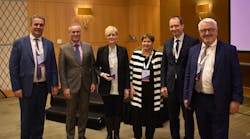DENTON (UNT), Texas — The Air Force Office of Scientific Research has awarded University Distinguished Research Professor Raj Banerjee from the University of North Texas College of Engineering and his research group a $900,000 grant. The funds will be used to develop and investigate multi-phase high entropy alloys – also referred to as complex-concentrated alloys – that are expected to revolutionize aircraft construction.
“This new class of materials is expected to substantially improve the performance of aircraft structural components by enhancing their mechanical properties, including fatigue and creep properties, at room and high temperatures,” Banerjee, who is part of the Department of Materials Science and Engineering, said.
Traditional high-performance structural alloys have multi-phase microstructures and are designed based on the principle of selecting a base element – such as iron – and adding limited amounts of alloying elements – such as chromium or nickel – to engineer their structure and properties through thermo-mechanical processing, making high-performance steels.
High entropy alloys, however, transform the traditional alloy process by employing concentrated amounts of multiple alloying elements, instead of a single one. The original concept of these alloys was that they form a single-phase solid solution despite their complex chemistry. However, the performance of these single-phase alloys is limited at elevated temperatures, which can be problematic for aircrafts exposed to varying levels of heat.
Banerjee says complex-concentrated alloys are the best of both worlds. He hopes through the use of computational and characterization tools, he can combine the multi-phase architecture of traditional alloys with the newer high entropy alloys to expand upon their performance and develop a new class of materials for enhanced structural performance in aircrafts and for other engineering applications.
“Research on high entropy alloys is expanding very rapidly worldwide and could potentially be a game changer in terms of the future development of structural and functional materials,” Banerjee said. “It has opened up a hitherto unexplored category of metallic alloys and, in principle, the concept can be expanded to other classes of materials, such as ceramics and semiconductors.”




